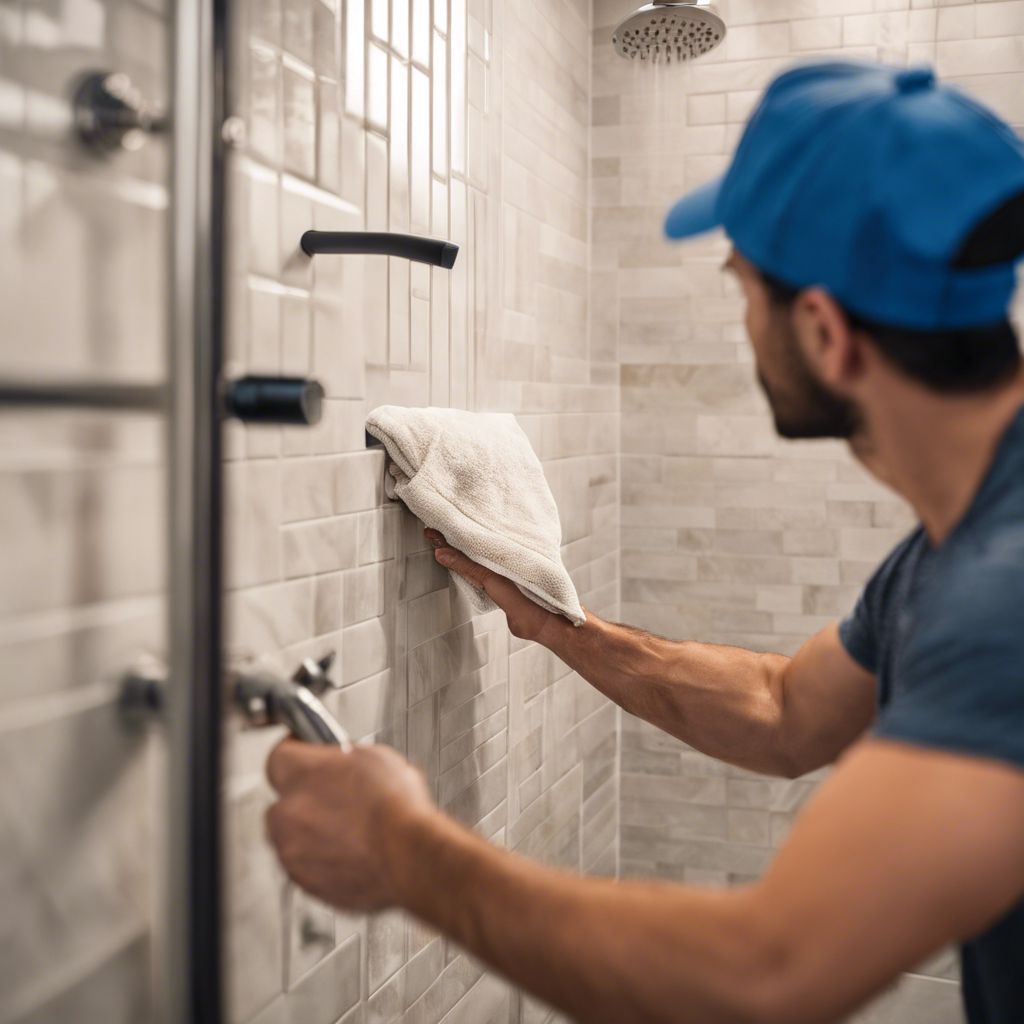
Key Takeaways
- Limestone shower tiles add elegance to a home but require regular maintenance to keep them looking great.
- Refinishing limestone can be a DIY project if you have the right tools and follow a clear, step-by-step guide.
- Assessing the condition of your limestone is essential before beginning any refinishing work.
- Using the appropriate cleaners and sealers designed for limestone will prevent damage during the refinishing process.
- Regular maintenance after refinishing will extend the life and beauty of your limestone shower.
Revitalize Your Space: Simple Guide to Limestone Shower Tiles Refinishing
Ready to give your bathroom a makeover? Say farewell to tired, lackluster tiles, and welcome a space that exudes freshness and warmth. With this easy step-by-step guide, you can refinish your limestone shower tiles without the hassle of a complete renovation. Get ready to enjoy a bathroom that’s not only beautiful but also a reflection of your personality and taste.
What You Need to Know About Limestone
Limestone is a well-loved material in home design, known for its earthy tones and natural feel. It’s a type of sedimentary rock that’s been used for centuries in building and sculpting. But its beauty comes with a caveat – limestone is porous and sensitive to acidic substances, meaning it can stain and etch easily. That’s why it’s essential to know how to care for it properly. Refinishing your limestone shower tiles will not only bring back their original luster but also protect them from future damage.
When to DIY vs. Call a Professional
Deciding whether to take on a DIY project or call a professional can be challenging. If you’re considering DIY refinishing limestone shower tiles, it’s essential to understand the scope of the project and your own skill level.
Let’s be honest, not all jobs are created equal. Some tasks can be tackled with a little elbow grease and determination, while others might require a professional touch. When it comes to refinishing limestone, the key is to assess the extent of the damage. If we’re talking about minor scuffs and dullness, roll up your sleeves – it’s DIY time. However, if your tiles are severely damaged or you’re unsure about the process, it might be wiser to call in a pro. No shame in that – better safe than sorry.
Gathering the Right Tools for the Job
Before we dive into the nitty-gritty, let’s talk tools. You wouldn’t paint a masterpiece without the right brushes, right? The same goes for refinishing your limestone shower. You’ll need:
- A mild, pH-neutral cleaner – because limestone doesn’t play well with acids.
- Grout filler – to patch up any cracks and crevices.
- Sanding pads – to smooth out the surface.
- Honing powder – if you’re going for that matte finish.
- Polish – to give your tiles that glossy magazine look.
- A quality sealer – to protect your handiwork.
And don’t forget the basics like gloves, sponges, and protective eyewear. Safety first, folks.

DIY Refinishing Limestone Shower Tiles Steps
Embarking on a DIY project to refinish your limestone shower tiles can be both exciting and rewarding. Get ready to roll up your sleeves and embark on a journey of creativity and transformation by following these steps.
Step 1: Analyze Your Limestone Tiles’ Condition
First up, we’re playing detective. Grab a flashlight and inspect your limestone tiles closely. What are you looking for? Signs of etching, uneven surfaces, cracks, and loose tiles. These clues will tell you how much work you’re in for. It’s like checking the weather before a hike – you want to be prepared for what’s ahead.
Identifying Common Limestone Problems
Before attempting any DIY refinishing of your limestone tiles, it’s vital to identify and understand the common problems that can affect limestone surfaces. This will ensure the right approach is taken to restore the stone’s beauty effectively.
Most issues with limestone stem from its porosity. Water, soap scum, and even that fancy bath oil can seep into the stone, causing discoloration and weakening the structure. Look out for:
- Stains that seem to have settled in for the long haul.
- Chips or cracks where water might have gotten too cozy.
- Loose tiles that rattle – a sign the adhesive might be giving up.
Take notes on what needs fixing. This will be your roadmap to a successful refinishing journey.
Step 2: Deep Cleaning and Stripping the Old Sealer
Before we can add any new shine to our limestone, we need to strip away the past. Over time, sealers can yellow and peel, leaving your tiles looking tired. So, let’s get to work and give them a deep clean. This step is like hitting the reset button on your shower tiles, preparing them for a fresh start.
Choosing the Right Cleaning Solutions
Remember, limestone is sensitive, so we’ll need a gentle cleaner. Skip those harsh chemicals and opt for a pH-neutral cleaner that’s safe for natural stone. Apply it with a soft sponge or brush, working in sections to ensure you’re covering every inch. And here’s a pro tip: let the cleaner sit for a few minutes to work its magic before scrubbing away.
Removing Old Sealant Without Damage
Once the limestone is clean, it’s time to remove the old sealer. This might require a commercial stone stripper, especially if the sealer is stubborn. Apply the stripper according to the manufacturer’s instructions and let it do its thing. After it’s had enough time to break down the old sealer, gently scrub the tiles with a soft-bristle brush. Rinse thoroughly with water and allow the tiles to dry completely. Patience is key here – rushing might mean missing spots, and we don’t want that.
Step 3: Repairing Grout and Tile Imperfections
Now it’s time to give some extra love to those grout lines and any imperfections in your tiles. Follow these steps:
- Start by inspecting the grout for any cracks or gaps that need attention.
- Using a grout saw or utility knife, carefully remove any damaged grout, making sure not to damage the surrounding tiles.
- Once the grout lines are clean and free of debris, mix up a batch of grout according to the manufacturer’s instructions.
- Using a grout float, apply the new grout evenly, making sure to fill in all the gaps.
- Wipe away any excess grout with a damp sponge, and let it dry according to the package instructions.
For any tile imperfections, such as chips or scratches, consider using a limestone repair kit to patch them up. With a little bit of patience and attention to detail, your tiles will be looking good as new in no time.
Step 4: Honing Your Limestone Tiles
Now, for those of you looking for that soft, matte finish, honing is your best friend. It’s all about creating a smooth surface that’s not too shiny, but just right.
To hone your limestone, you’ll need honing powder and a honing pad. Sprinkle the powder over your wet tiles and work it in with the pad in a circular motion. It’s like exfoliating your skin – you’re getting rid of the old, dull outer layer to reveal the fresh, new surface underneath.
Keep at it until you’ve achieved the desired level of smoothness. Rinse the tiles well and wipe them down.
Understanding the Honing Process
For those who are unfamiliar, honing is a gentle abrasion process that removes minor scratches and evens out the surface of your limestone. It’s the secret to getting rid of that dull, lifeless look and prepping the stone for a new sealant.
DIY Honing vs Professional Honing
DIY honing is doable, but it requires a bit of elbow grease and patience. If your shower isn’t too bad, you can give it a go. But, if your tiles are as rough as a stormy sea, or you’re unsure about the process, calling in a professional might be your best bet. They’ve got the tools and know-how to get it done right.
Step 5: Polishing for Shine and Protection
If you’re a fan of that glossy, magazine-worthy look, polishing is where it’s at. After honing, your limestone is prepped and ready for some shine.
DIY Polishing Methods
Polishing is like the icing on the cake. You’ll need a polishing powder and a soft cloth or buffing pad. Sprinkle the powder over the tiles and buff it in gently. Work in small sections and take your time. As you buff, you’ll start to see the tiles come to life with a beautiful, reflective shine. It’s like watching your shower transform before your eyes.
Choosing the Right Polish for Limestone
Not all polishes are created equal. You want a polish that’s specifically designed for limestone to avoid any damage. Look for products labeled for use on natural stone, and always test it on a small, inconspicuous area first. This will ensure that you’re getting the finish you want without any surprises.
Step 6: Sealing for Long-Lasting Results
We’ve cleaned, honed, and polished, and now it’s time to seal the deal. Sealing is like setting a protective barrier over your limestone – it’s the final step to ensure all your hard work pays off.
Applying Sealant Evenly and Efficiently
Applying sealant is a breeze. Make sure the tiles are completely dry, then apply the sealant with a soft cloth or brush, covering every inch of the limestone. Let it penetrate the stone for the time specified by the manufacturer, then wipe off any excess. It’s like putting sunscreen on before a day at the beach – you’re protecting your limestone from the elements.
Once the sealant has cured, your limestone shower will not only look stunning, but it’ll also be more resistant to water, soap scum, and those pesky stains. And just like that, you’ve given your shower a new lease on life.
Understanding Sealant Cure Times
Think of sealant as the guardian of your limestone shower tiles. But even guardians need time to prepare. After you’ve applied the sealant, it needs to cure. This is when the sealant dries and sets, forming that protective barrier we talked about. The cure time can vary depending on the product, but it’s usually around 24 to 48 hours. During this time, keep the shower dry and free from traffic. It’s a little like waiting for paint to dry – not the most exciting part, but absolutely essential for a job well done.

Care Tips to Maintain Refinished Limestone Shower Tiles
Now that your shower tiles are looking fresh and revitalized, it’s time to keep them that way. Consistent cleaning and proactive measures against future damage and stains are key to maintaining the beauty of your refinished tiles.
Daily Cleaning Practices
After all that hard work, you’ll want to keep your limestone looking its best. The secret? It’s all about the daily routine. Wipe down your shower tiles after each use to prevent water spots and build-up. Use a squeegee or a soft cloth – it’s a small step that makes a big difference. And for weekly cleaning, stick with that pH-neutral cleaner we talked about earlier. Gentle is the way to go.
Preventing Future Damage and Stains
Beyond daily cleaning, there are a few other tricks to keep your limestone in tip-top shape. Make sure your bathroom is well-ventilated to avoid excess moisture, which can lead to mold and mildew. And be mindful of the products you bring into the shower. Harsh chemicals and dyes can stain or etch the limestone, undoing all your hard work. When in doubt, test a new product on a small, hidden area first.

Frequently Asked Questions
How often should limestone tiles be refinished?
Understanding the right frequency for refinishing limestone tiles can ensure their longevity and beauty. While there’s no one-size-fits-all answer, a good rule of thumb is to consider refinishing your limestone tiles every few years, depending on the level of wear and tear they’ve endured.
Keep an eye on the finish – when it starts to look dull or you notice some staining, it’s time for a refresh. It’s like giving your car a tune-up; regular check-ins will keep it running smoothly.
Can DIY refinishing produce results as good as professional services?
Absolutely! With the right tools, a bit of knowledge, and a dose of patience, DIY refinishing can yield stunning results. Just follow the steps carefully, don’t rush the process, and pay attention to the details.
What safety precautions should I take when refinishing limestone tiles?
When undertaking a project like refinishing limestone tiles, it’s important to follow safety guidelines to protect yourself and your home. Ensure you wear protective gear, work in a well-ventilated area, and follow the product instructions carefully.
How do I know if my limestone tiles need to be resealed?
There’s a simple test for that. Sprinkle a few drops of water onto the tiles. If the water beads up, you’re still sealed tight. But if it soaks in, leaving a dark mark, it’s time to reseal. Think of it like checking the oil in your car – it’s a quick way to see if you need a top-up.
Can I change the finish of my limestone tiles from glossy to matte or vice versa?
Changing the finish of your limestone is definitely possible. It’s all about the honing and polishing stages. For a matte finish, stop after honing. If you want gloss, proceed to polish. It’s like choosing a paint finish – matte, eggshell, or glossy – it’s up to you and the look you’re going for.
So there you have it — a complete guide to refinishing your limestone shower tiles. With these steps, tips, and care practices, you can bring back the beauty of your limestone shower tiles and keep it looking great for years to come. Happy refinishing!





Leave a Reply